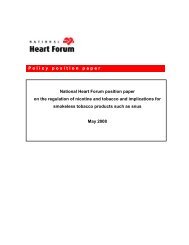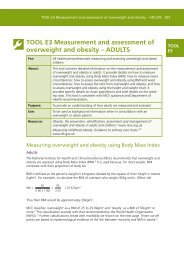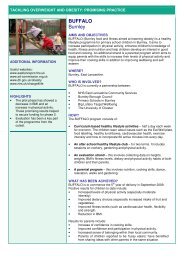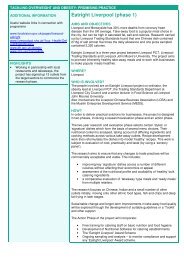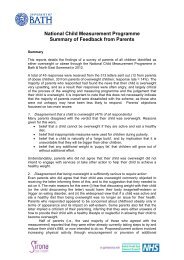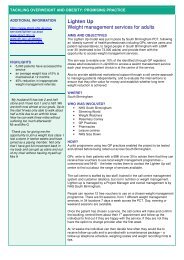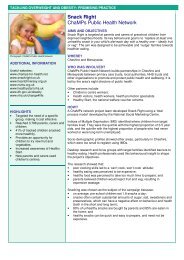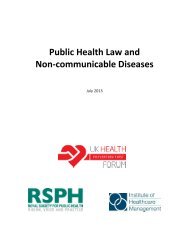The Challenge of Non-Communicable Diseases and Road Traffic ...
The Challenge of Non-Communicable Diseases and Road Traffic ...
The Challenge of Non-Communicable Diseases and Road Traffic ...
Create successful ePaper yourself
Turn your PDF publications into a flip-book with our unique Google optimized e-Paper software.
An Overview 53<br />
some NCD prevention [79]. Many African LMIC<br />
are heavily reliant on external financing. External<br />
resources for health as a percentage <strong>of</strong> THE in 2010<br />
ranged from 2 percent in Mauritius <strong>and</strong> Equatorial<br />
Guinea to 63.8 percent in Malawi. External financing<br />
is volatile <strong>and</strong> uncertain, <strong>and</strong> a big issue for SSA<br />
is the fungibility <strong>of</strong> government spending <strong>and</strong> donor<br />
spending. <strong>The</strong>re is evidence <strong>of</strong> a strong substitution<br />
effect, with donor funding for health substituting for<br />
health financing by recipient governments, the effect<br />
being largest in low-income countries [368]. Donor<br />
funding for NCDs is negligible, comprising only<br />
about 2-3 percent <strong>of</strong> overall development assistance<br />
for health in 2007.<br />
Some LMIC – notably Rw<strong>and</strong>a <strong>and</strong> Ghana – have<br />
made significant progress in developing financing<br />
systems towards universal coverage, although fragmentation<br />
<strong>and</strong> sustainability can be a continuing<br />
problem. Many people have little financial protection<br />
against the high costs <strong>of</strong> health care. More than<br />
half (51 percent) <strong>of</strong> THE in the WHO African Region<br />
is private health expenditure (global average<br />
37.1 percent) <strong>of</strong> which more than half (55.6 percent)<br />
is out-<strong>of</strong>-pocket, ranging from 8.1 percent in<br />
the Seychelles to 90 percent in Guinea-Bissau [367].<br />
WHO estimates that if the proportion <strong>of</strong> THE that is<br />
out-<strong>of</strong>-pocket is below 15-20 percent, the incidence<br />
<strong>of</strong> financial catastrophe caused by such expenses is<br />
negligible: in 2010, only 7 SSA countries were below<br />
the threshold <strong>of</strong> 15 percent [369-370]. Only 5-10<br />
percent <strong>of</strong> people in SSA are covered by social protection<br />
in the event <strong>of</strong> lost wages during illness or<br />
pregnancy [371].<br />
Available resources must be used efficiently <strong>and</strong><br />
equitably to realize potential gains in health outcomes.<br />
A study <strong>of</strong> Tanzania, Ghana <strong>and</strong> South Africa<br />
found that although overall health care financing was<br />
progressive in all three countries, the distribution <strong>of</strong><br />
service benefits favored richer people, despite illness<br />
burden being greater amongst lower-income groups,<br />
<strong>and</strong> access to necessary services was the main challenge<br />
to universal coverage [372].<br />
Responses<br />
Many countries have embraced the goal <strong>of</strong> “universal<br />
health coverage”, aiming to ensure equitable<br />
access to effective health services (promotion, prevention,<br />
treatment, <strong>and</strong> rehabilitation) when needed<br />
<strong>and</strong> without incurring financial hardship for the<br />
whole population. To achieve this, countries need a<br />
health-financing system that raises sufficient funds,<br />
protects people from financial impoverishment associated<br />
with health care costs, <strong>and</strong> uses resources<br />
efficiently [371, 373]. This requires balancing trade<strong>of</strong>fs<br />
among the populations, services, <strong>and</strong> costs that<br />
can realistically be covered.<br />
Moving towards universal health coverage, as for<br />
example in Ghana, South Africa, <strong>and</strong> Tanzania, requires<br />
less-fragmented financing arrangements, less<br />
reliance on out-<strong>of</strong>-pocket payments at the point <strong>of</strong><br />
service, increased financial protection for people in<br />
the informal sector, <strong>and</strong> more equitable allocation <strong>of</strong><br />
public resources [374].<br />
Ways <strong>of</strong> raising additional resources for health include<br />
better revenue collection, increasing the share<br />
<strong>of</strong> government budgets for health, <strong>and</strong> more innovative<br />
means such as increasing excise taxes on tobacco<br />
<strong>and</strong> alcohol. As African countries with rich endowments<br />
<strong>of</strong> natural resources largely do not have good<br />
human development outcomes, including in health,<br />
natural resource wealth-management should consider<br />
both the long-term requirements for economic<br />
growth when these revenues dwindle, as well as the<br />
immediate need to increase public investment in<br />
health, education, <strong>and</strong> social protection to cut poverty,<br />
reduce inequality, <strong>and</strong> build human capital as<br />
a key contributing factor to diversified growth over<br />
the medium <strong>and</strong> longer terms [375]. International<br />
aid may need to be restructured to better align incentives<br />
<strong>and</strong> goals. Performance- or results-based financing<br />
(RBF) which links funding to performance<br />
has been promoted as a means <strong>of</strong> achieving this. It<br />
has been used for example by the Global Fund in<br />
HIV, TB, <strong>and</strong> Malaria programs [376] <strong>and</strong> the World<br />
Bank as a way <strong>of</strong> incentivizing health workers <strong>and</strong><br />
health providers towards the achievement <strong>of</strong> health<br />
goals. Overall, the evidence for the effectiveness <strong>of</strong><br />
these strategies in improving health care <strong>and</strong> health<br />
in LMIC is mixed, <strong>and</strong> results depend on the design<br />
<strong>of</strong> the intervention; for example, who receives payments,<br />
the size <strong>of</strong> the incentives, the targets <strong>and</strong> how<br />
they are measured, additional funding <strong>and</strong> support,<br />
<strong>and</strong> contextual factors [377]. Rigorous evaluation <strong>of</strong><br />
a r<strong>and</strong>omized study in Rw<strong>and</strong>a demonstrated large



